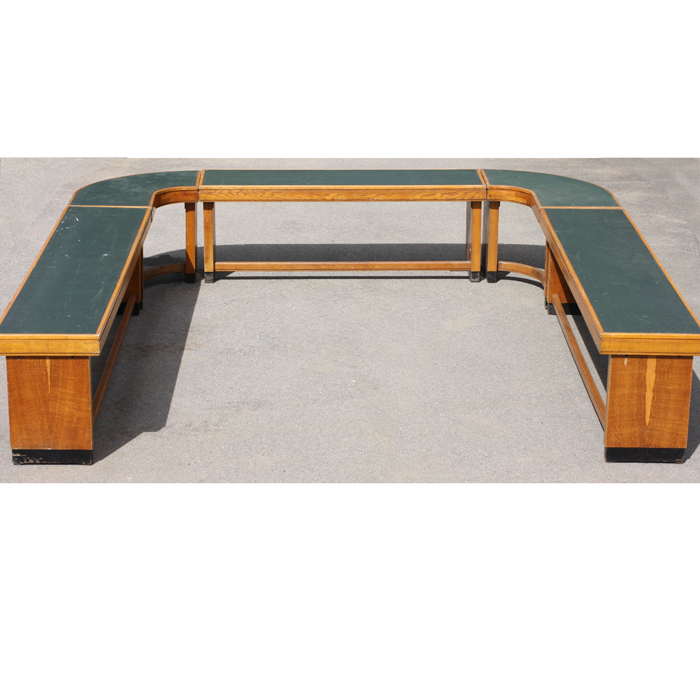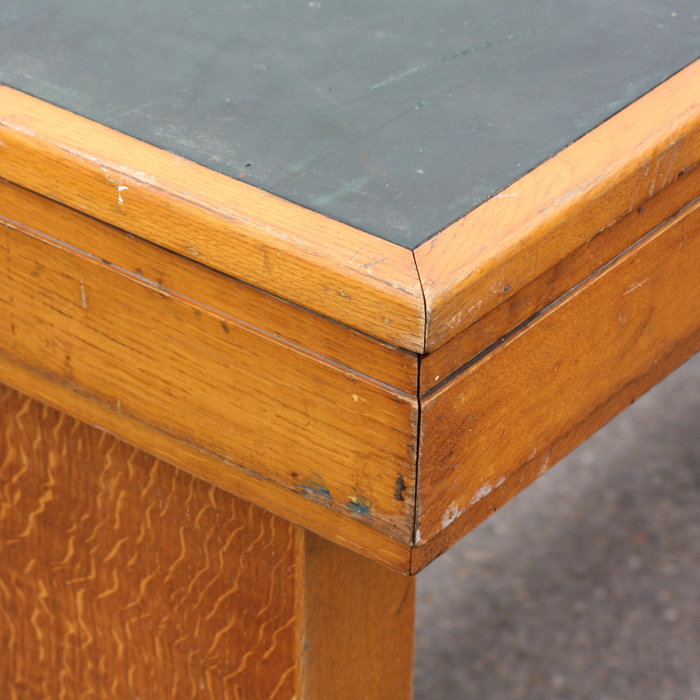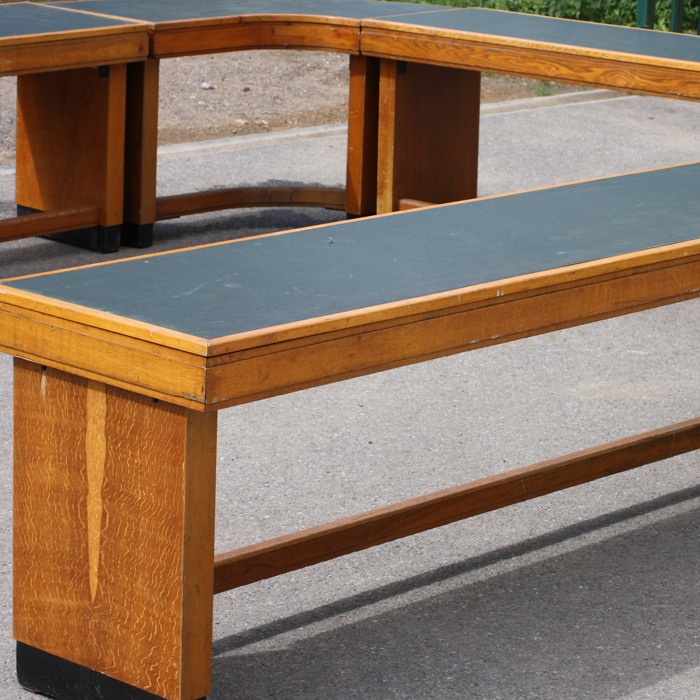No products in the basket.
Archived Stock - This item is no longer available
An Art Deco oak-veneered leatherette-topped boardroom table,
salvaged from Brooklands "The Home of British Motor Sport, Aviation & Concorde", and thought to have furnished a meeting room at Vickers Armstrong (later BAC),
the suite of tables, three straight and two curved corner sections, with a stepped moulded edge and plinth supports finished wth book-matched veneer, linked by stretchers to one side,
SOLD OUT
In stock
Watch out for numerous items salvaged by LASSCO from Brooklands - we've just completed an interesting clearance.
Research continues as to which building this table may have originated from at Brooklands but the most likely contender is Vickers whose extensive hangars, runways, factories, workshops and offices were here alongside Malcolm Campbell's famous banked racing circuit. Both for Motor-sport and for Aviation, Brooklands near Weybridge in Surrey is at the heart of their history. This an excerpt from Historic England's summary of the site.
The world's first purpose- built motor racing track at Brooklands employed state of the art technology and was described as one of the seven wonders of the modern world. Lying between Weybridge and Byfleet, the race circuit was constructed in 1907 on `Brooklands', the private estate of the Hugh Locke King. Financed and built entirely on his own initiative, Locke-King intended the new facility to be a showcase for British motor engineering and motor sport. Enclosing an area of 300 acres, the outer circuit was constructed in just nine months by a workforce of 1500 men at a cost of £150,000. In 1937 in response to new circuits at Donington Park and Crystal Palace a road-racing circuit designed by Sir Malcolm Campbell was opened at Brooklands. In addition to including completely new sections of track, the so-called `Campbell Circuit' utilized portions of the existing circuit and a ferro-concrete bridge over the River Wey built prior to 1934 to allow Vickers aircraft to be towed from their factory to the east of the circuit on to the aerodrome. A series of concrete pits were constructed alongside the section of the new circuit (the `New Finishing Straight') running parallel with the old Finishing Straight.
The great names of the inter-war British motor industry, such as Austin, Vauxhall, Norton and Triumph owed much of their success to the availability of the Brooklands track, which proved itself as a valuable testing ground for engine development, tyre safety and streamlining. In the 32 years that it was in use the Brooklands circuit achieved both a number of firsts and was the venue for a series of successful world record attempts. In 1907 S.F Edge broke the 24 hour endurance record by covering a distance of 1581 miles; in 1913 Percy Lambert became the first person to drive 100 miles in one hour; and in 1909 the World Land Speed record was broken at Brooklands, the first of three occasions. In 1926 the circuit also provided the venue for Britain's first Grand Prix.
In addition to its importance to motor racing, the site was also of great importance in the realm of aviation. In 1907 both Claude Moore Brabazon and Alliott Verdon Roe attempted to fly aeroplanes of their own design at Brooklands without success. On June 8th 1908, however, another attempt by Roe was more successful and he became the first Briton ever to fly a British-designed aeroplane. Thereafter the new aerodrome within the circuit rapidly became the focal point for the country's burgeoning aviation industry, including aircraft production, flying training and passenger flights. ... In 1909 Britain's first public flying demonstration was held at the aerodrome and in 1910 Lane's Flying School opened, followed in 1911 by Vickers' Flying School. In the same year the first passenger flight ticket was sold at Brooklands by Keith Prowse and Co, ... Motor racing ceased at Brooklands in 1939 and at the start of World War II both the airfield and circuit were requisitioned for use by the Vickers and Hawker aircraft companies, most of the Hurricanes that brought victory in the Battle of Britain being built at Brooklands.
Formerly lying immediately outside the track to the east, the Vickers factory was rapidly expanded, with buildings erected across the area of the outer circuit from a point north of the Byfleet Banking bridge to the southern half of the Finishing Straight. In addition wartime hangars were erected on the Members' Banking, the northern end of the Finishing Straight and the Railway Straight. On 4th September 1940, during the Battle of Britain, the Vickers factory was badly bombed by the Luftwaffe causing severe casualties amongst the workforce. The anti-aircraft guns at Brooklands were in action on 33 occasions from the time of the raid up until May 1941 and shot down two aircraft. Some time between early 1941 and the start of 1942 the defences at Brooklands were further enhanced by the construction of a reinforced concrete tower (Scheduled Ancient Monument) on the Members' Hill. The tower, split into two parts, mounted a 40mm Bofors gun and its predictor gear and was intended to provide a clear field of fire against low-flying raiders. Additional provision for the protection of the Vickers workforce was made with the construction of brick and concrete lined air raid shelters cut beneath the foot of Members' Hill."



